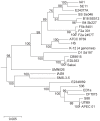Derivation of Escherichia coli O157:H7 from its O55:H7 precursor
- PMID: 20090843
- PMCID: PMC2806823
- DOI: 10.1371/journal.pone.0008700
Derivation of Escherichia coli O157:H7 from its O55:H7 precursor
Abstract
There are 29 E. coli genome sequences available, mostly related to studies of species diversity or mode of pathogenicity, including two genomes of the well-known O157:H7 clone. However, there have been no genome studies of closely related clones aimed at exposing the details of evolutionary change. Here we sequenced the genome of an O55:H7 strain, closely related to the major pathogenic O157:H7 clone, with published genome sequences, and undertook comparative genomic and proteomic analysis. We were able to allocate most differences between the genomes to individual mutations, recombination events, or lateral gene transfer events, in specific lineages. Major differences include a type II secretion system present only in the O55:H7 chromosome, fewer type III secretion system effectors in O55:H7, and 19 phage genomes or phagelike elements in O55:H7 compared to 23 in O157:H7, with only three common to both. Many other changes were found in both O55:H7 and O157:H7 lineages, but in general there has been more change in the O157:H7 lineages. For example, we found 50% more synonymous mutational substitutions in O157:H7 compared to O55:H7. The two strains also diverged at the proteomic level. Mutational synonymous SNPs were used to estimate a divergence time of 400 years using a new clock rate, in contrast to 14,000 to 70,000 years using the traditional clock rates. The same approaches were applied to three closely related extraintestinal pathogenic E. coli genomes, and similar levels of mutation and recombination were found. This study revealed for the first time the full range of events involved in the evolution of the O157:H7 clone from its O55:H7 ancestor, and suggested that O157:H7 arose quite recently. Our findings also suggest that E. coli has a much lower frequency of recombination relative to mutation than was observed in a comparable study of a Vibrio cholerae lineage.
Conflict of interest statement
Figures




Similar articles
-
Escherichia coli serotype O55:H7 diversity supports parallel acquisition of bacteriophage at Shiga toxin phage insertion sites during evolution of the O157:H7 lineage.J Bacteriol. 2012 Apr;194(8):1885-96. doi: 10.1128/JB.00120-12. Epub 2012 Feb 10. J Bacteriol. 2012. PMID: 22328665 Free PMC article.
-
Evolution of genomic content in the stepwise emergence of Escherichia coli O157:H7.J Bacteriol. 2005 Mar;187(5):1783-91. doi: 10.1128/JB.187.5.1783-1791.2005. J Bacteriol. 2005. PMID: 15716450 Free PMC article.
-
Acquisition of the rfb-gnd cluster in evolution of Escherichia coli O55 and O157.J Bacteriol. 2000 Nov;182(21):6183-91. doi: 10.1128/JB.182.21.6183-6191.2000. J Bacteriol. 2000. PMID: 11029441 Free PMC article.
-
In silico genomic analyses reveal three distinct lineages of Escherichia coli O157:H7, one of which is associated with hyper-virulence.BMC Genomics. 2009 Jun 29;10:287. doi: 10.1186/1471-2164-10-287. BMC Genomics. 2009. PMID: 19563677 Free PMC article.
-
Prevalence, distribution and evolutionary significance of the IS629 insertion element in the stepwise emergence of Escherichia coli O157:H7.BMC Microbiol. 2011 Jun 14;11:133. doi: 10.1186/1471-2180-11-133. BMC Microbiol. 2011. PMID: 21672218 Free PMC article.
Cited by
-
Identification of a novel prophage regulator in Escherichia coli controlling the expression of type III secretion.Mol Microbiol. 2012 Jan;83(1):208-23. doi: 10.1111/j.1365-2958.2011.07927.x. Epub 2011 Dec 9. Mol Microbiol. 2012. PMID: 22111928 Free PMC article.
-
Molecular characterization of pathogenic Escherichia coli isolated from diarrheic and in-contact cattle and buffalo calves.Trop Anim Health Prod. 2020 Nov;52(6):3173-3185. doi: 10.1007/s11250-020-02343-1. Epub 2020 Jul 10. Trop Anim Health Prod. 2020. PMID: 32647966 Free PMC article.
-
Escherichia coli O157:H7 senses microbiota-produced riboflavin to increase its virulence in the gut.Proc Natl Acad Sci U S A. 2022 Nov 29;119(48):e2212436119. doi: 10.1073/pnas.2212436119. Epub 2022 Nov 21. Proc Natl Acad Sci U S A. 2022. PMID: 36409903 Free PMC article.
-
Pathogenomes and variations in Shiga toxin production among geographically distinct clones of Escherichia coli O113:H21.Microb Genom. 2022 Apr;8(4):000796. doi: 10.1099/mgen.0.000796. Microb Genom. 2022. PMID: 35394418 Free PMC article.
-
Pathogenomes of Atypical Non-shigatoxigenic Escherichia coli NSF/SF O157:H7/NM: Comprehensive Phylogenomic Analysis Using Closed Genomes.Front Microbiol. 2020 Apr 15;11:619. doi: 10.3389/fmicb.2020.00619. eCollection 2020. Front Microbiol. 2020. PMID: 32351476 Free PMC article.
References
Publication types
MeSH terms
Grants and funding
LinkOut - more resources
Full Text Sources
Other Literature Sources
Molecular Biology Databases

